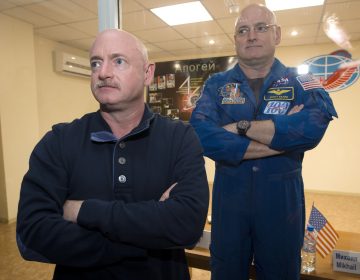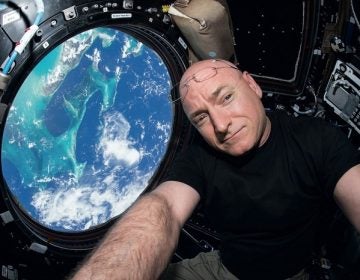Rings, Centaurs, and Known Science
Listen 00:05:55Four planets of our solar system have rings – Saturn, Jupiter, Uranus and Neptune. Astronomers can now identify at least two non-planetary objects with rings. They’re Centaurs – a specific class of asteroid that has qualities of both a comet and asteroids with orbits between Jupiter and Pluto.
We see the universe as it is – in snapshot – both in what’s there now and in what we know now. We don’t know all about the universe or even the solar system for that matter so it leaves many mysteries to be solved.
Spring constellations dominate the sky now. Gemini, Cancer, Leo, Virgo, Bootes, Hercules. Easy to find the Big Dipper now – right above Leo the Lion!
April 13, 2015
[Dave Heller] Almost everybody knows that Saturn is the ringed planted but rings are more prolific than that in our solar system. Let’s get into it with Derrick Pitts, Chief Astronomer at the Franklin Institute. 24 Carrot?
[Derrick Pitts] If only they were. What we see of the rings in our solar system, we’ve figured out that they really are just small hunks of ice and dirt and rocks and things like that. So we now know that Saturn has a whole slew of moons, many more than we learned about in elementary school. Like we knew that Jupiter had 9 and Saturn had 12 but now we find that Saturn has more than 50 moons and Jupiter has nearly 65 or more, but they get smaller and smaller as you move away from the planet. Well, the tug that happens between the large mass of the planet itself and the other bodies that orbit it, sometimes cause enough pull that objects orbiting really close get into a little zone where things can’t exist as one whole piece and breaks up into smaller pieces.
[Dave Heller] So where else besides Jupiter and Saturn does this tug take place?
[Derrick Pitts] As it turns out we found that this tug takes place at the other gas giants of our solar system, both Uranus and Neptune. They both have rings. In addition we’ve also found that there are rings that orbit other bodies; asteroids of our solar system and a specific class of asteroids known as centaurs.
[Dave Heller] Centaurs?
[Derrick Pitts] Not half man, half horse but the same idea because these particular asteroids have characteristics of both comets and asteroids. They orbit between Jupiter and Pluto.
[Dave Heller] This is another ringed system, even though it is on an itty-bitty asteroid?
[Derrick Pitts] Yeah, that’s the interesting thing. We never thought there would be that kind of activity in that region of the solar system among those bodies of objects. But as it turns out maybe we don’t really get the full picture of what’s happening in the solar system as we thought we had because not only do we find that these two objects have rings, but we also find that part of the reason they may have rings may is because they may also have jets of gas, like water vapor, squirting out of them that may contribute to the ring system, thus the characteristics much more like a comet than an asteroid.
[Dave Heller] Derrick, let’s explore this notion of getting the full picture, not just about this one focus on centaurs for example but about knowledge about the universe in general.
[Derrick Pitts] We look at the universe today, we see it as it is. Yes, of course, as we look further back out into the universe we see farther back in time and all those sorts of things, but it is still just a snapshot. It’s a snapshot of a process that has taken place over an extraordinarily long period of time. The first number we say is 13 billion years, that we can see that far out into the observable universe. And indeed the universe is older than that because we can’t see beyond 13 billion years because it is taking the light too long to get to us. But if we look back over time, out understanding of the development of this universe, coming to this stage, allowed for us to see all of the matter of the universe and then there were all those voids in between the matter and so we assumed that it is just empty space, it’s vacuum…only to find out that the universe isn’t behaving as we expected. We expected that the expansion of the universe was slowing at the furthest extremes. Upon close observation within the last 2 decades what we’ve discovered instead is that the universe is expanding. And it looks like it will continue because we’ve now been able to identify that that expansion is caused by the actions of dark matter and dark energy. Components of the universe that we did not know existed before, but as we observe their effect on other things we begin to realize that the universe is actually comprised more of dark energy and dark matter than the matter we see. So here is one of those instances that in which we look at the universe as we see it now but unless we understand some processes that went on before we don’t really get all that is that shapes what the universe is today.
[Dave Heller] We can truly thank who ever came up with the truism nature and the universe abhors a vacuum.
[Derrick Pitts] Yes, absolutely there is no question about that. Yet scientists and researches try and create models, simulations of a process that would cause matter to develop into what we see now taking into account all of the things we know about the universe.
[Dave Heller] Derrick, we have a minute left, let’s come back to our itty bitty portion of the universe, what’s available to be seen in the night sky this week?
[Derrick Pitts] We have gorgeous spring constellations available if we start sort of over on the western side of the sky after sunset we can still see Orion the hunter down low in the southwest. But above Orion we see the Gemini twins easily; to their left over toward the east we see the constellation Cancer the crab, its sort of hard to see, the stars aren’t very bright but Jupiter is there so if you see the bright planet Jupiter you know you’re looking towards the stars in the constellation Cancer. Farther to the east we come upon the beautiful constellation Leo the lion. Leo if very helpful to us these days because, if we look at the lion, that backward question mark that marks the head and then the tail that looks like a triangle pointed toward the east directly; about that we can see the Big Dipper really easily. If we continue pushing over to the east we find, low down on the eastern horizon after dark, the great constellation Hercules where there is a beautiful globular cluster just waiting to be seen in a pair of binoculars or a small telescope.
WHYY is your source for fact-based, in-depth journalism and information. As a nonprofit organization, we rely on financial support from readers like you. Please give today.




